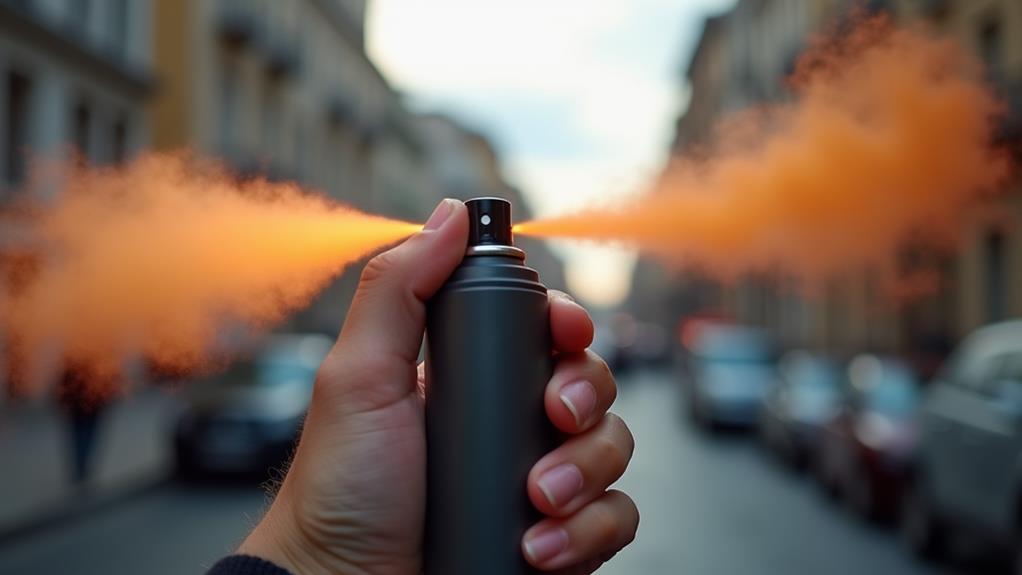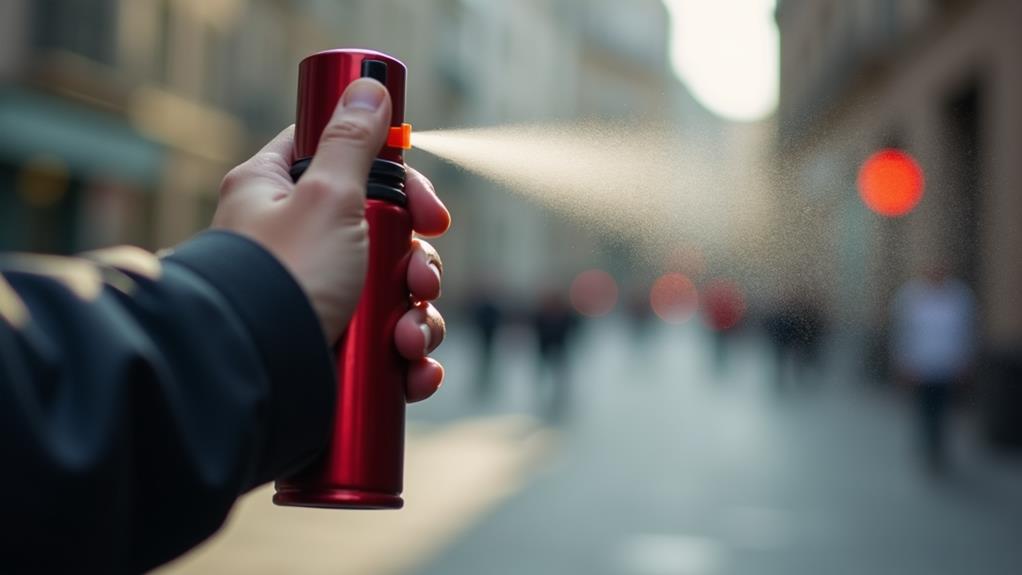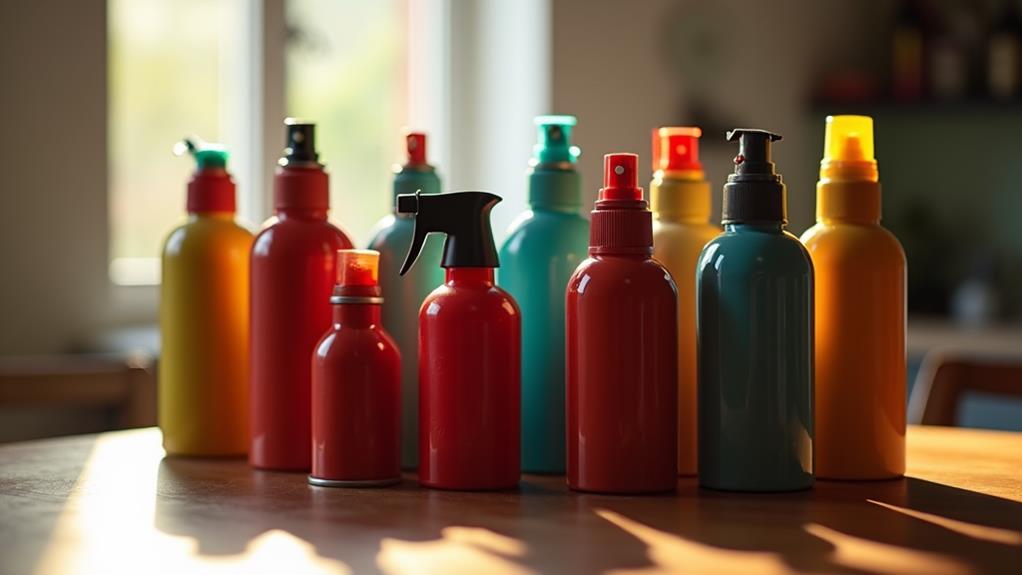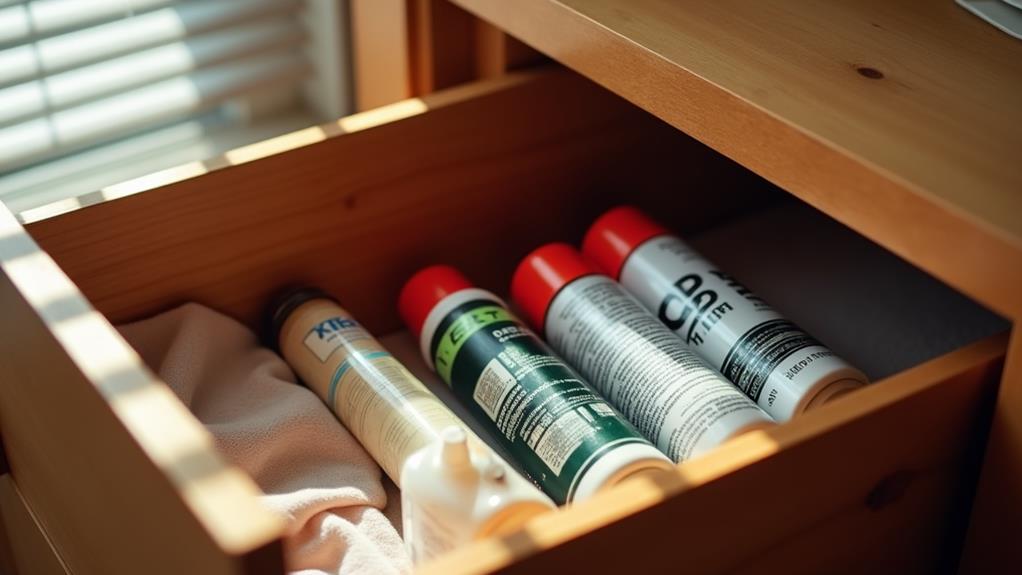Using non-lethal pepper spray for personal defense offers an effective way to boost your safety without relying on physical strength. Derived from hot peppers, it can cause temporary blindness and respiratory distress, giving you a chance to escape. Its compact size and simple point-and-spray mechanism make it ideal for quick reactions and require minimal training. Sprays vary in type and potency, so choose one that matches your lifestyle and environmental needs. Always be mindful of legal restrictions and safe usage guidelines. If you're curious about maximizing its effectiveness or proper maintenance, there's more to uncover.
Key Takeaways
- Pepper spray causes temporary blindness and respiratory distress, enabling quick escape from attackers.
- Lightweight and compact design allows for easy portability and quick access during emergencies.
- Effective range of up to 18 feet offers a safe distance for self-defense.
- Simple point-and-spray mechanism requires minimal training for effective use.
- Legal restrictions vary by state; regular research ensures compliance with local laws.
Understanding Pepper Spray

Pepper spray is a popular self-defense tool that offers non-lethal protection. You might be curious about its origins and effectiveness.
Historically, pepper spray's active ingredient, oleoresin capsicum, comes from hot peppers. Its use dates back centuries when ancient civilizations utilized ground peppers to fend off enemies. Modern pepper spray was developed in the 1960s, initially for riot control and crowd management. Since then, it's evolved into a widely used personal defense product, such as the Mace® Jogger Pepper Spray Pink, which is specifically designed for outdoor activities.
Understanding pepper spray's effectiveness is essential. It works by irritating the eyes, skin, and respiratory system of an attacker, causing temporary blindness, breathing difficulty, and intense discomfort. This incapacitating effect gives you time to escape or seek help.
Remember that pepper spray doesn't rely on physical strength or precision, making it accessible for everyone. Its effectiveness depends on several factors, such as the spray's concentration, the distance from the attacker, and environmental conditions like wind.
When considering pepper spray for personal defense, it's important to familiarize yourself with its history and proven effectiveness. This understanding can empower you to make informed decisions about your safety and choose pepper spray as a reliable tool for self-defense.
Benefits of Pepper Spray
Among the various self-defense options available, pepper spray stands out for its unique benefits. Its portability, ease of use, and immediate incapacitating effect make it a popular choice among individuals seeking non-lethal protection.
When you consider effectiveness comparison, pepper spray consistently ranks high because it can deter an attacker from a safe distance, giving you essential time to escape. For instance, some products like the Mace Pepper Gel Night Defender offer an effective range of up to 18 feet, enhancing its utility in diverse situations. Additionally, the built-in LED light feature is especially useful for nighttime defense scenarios, illuminating the area and aiding in precise targeting.
Here are some benefits of using pepper spray:
- Portability: It's lightweight and compact, fitting easily in pockets or bags, so you can carry it wherever you go.
- Ease of Use: With simple point-and-spray mechanics, you don't need extensive training to use it effectively.
- Immediate Effect: It causes temporary blindness and breathing difficulties to assailants, allowing you a quick getaway.
User testimonials frequently highlight how pepper spray has made them feel safer and more confident in precarious situations. Many users praise it for its simplicity and reliability, often citing personal experiences where it has successfully thwarted potential threats.
Unlike other self-defense tools, which might require physical strength or skill, pepper spray offers peace of mind, knowing you have a trusted, effective option at your fingertips.
How Pepper Spray Works

Understanding how pepper spray works can empower you to use it effectively when needed. At its core, pepper spray is made from spray ingredients derived from chili peppers, specifically capsaicin. This powerful component is what causes the intense burning sensation. The Mace Maximum Strength Formula contains 10% OC Pepper, which enhances its effectiveness.
When you deploy the spray, it creates a mist or stream that targets the eyes, nose, and throat of an attacker, temporarily incapacitating them.
The spray effectiveness hinges on both the concentration of capsaicin and the delivery method. Most commercial pepper sprays contain a concentration between 0.18% and 1.33% capsaicin, which is sufficient to cause immediate pain, inflammation, and difficulty breathing.
It's important to aim for the face, as this maximizes the pepper spray's impact by directly affecting the mucous membranes.
Legal Considerations
When considering carrying pepper spray for personal defense, it's vital to understand the legal landscape surrounding its use and possession. Each state has its own set of laws, and it's important to familiarize yourself with them.
State laws can dictate who can carry pepper spray, where you can carry it, and how it should be used. You'll want to pay attention to:
- Regulatory restrictions: Some states have specific rules about the size and formulation of pepper spray canisters.
- Age requirements: Many states require you to be a certain age, often 18, to purchase or possess pepper spray.
- Permitted uses: Generally, pepper spray is intended for self-defense, but misuse can lead to legal consequences.
Transportation guidelines are another significant aspect. For instance, airlines have strict rules about carrying pepper spray on board, and violating these can result in severe penalties.
Usage penalties also vary by state; inappropriate or unjustified use might lead to fines or even criminal charges.
To stay on the right side of the law, always research your specific state's requirements and follow them diligently. It's wise to check for any updates regularly, as regulations can change, impacting how you carry and use pepper spray.
Choosing the Right Spray

Selecting the right pepper spray for personal defense can be essential to guaranteeing your safety and peace of mind. With numerous spray types available, choosing the best one for your needs may seem overwhelming.
First, consider the various types: stream, cone, foam, and gel. Stream sprays offer a direct, long-range option but require precise aim. Cone sprays create a wider mist, increasing your chance of hitting the target, but they can be affected by wind. Foam and gel options reduce wind disruption and minimize blowback, making them ideal for indoor use or crowded areas.
Next, assess the spray strength. Pepper sprays typically range from 0.18% to 3% major capsaicinoids. A higher percentage indicates greater potency, but stronger isn't always better if it sacrifices your ability to accurately deploy it. Guarantee you can confidently handle and aim the chosen spray strength.
Lastly, think about your lifestyle and environment. If you frequently walk alone at night, a compact size might be ideal for quick access. For those in high-risk professions, a larger canister might be more appropriate.
Safe Usage Tips
To guarantee your safety while using pepper spray, it's important to understand and follow key safe usage tips. First, familiarize yourself with proper training techniques. Practicing with a water-filled practice canister can help you build confidence and accuracy.
It's vital to know how to hold and aim the spray effectively, making sure you're ready when situations arise. Engage in effective deployment by maintaining a safe distance from the threat. Ideally, you should be about 6 to 10 feet away when using pepper spray. This distance allows you to protect yourself while keeping the attacker at bay.
Remember that wind direction can impact the spray's effectiveness, so always consider your environment before deploying the spray.
To enhance your readiness, consider the following important tips:
- Practice regularly: Regular practice with your pepper spray will improve your reaction time and accuracy.
- Stay aware of your surroundings: Always be mindful of your environment to prevent accidental exposure.
- Know your product: Understand the specific features and limitations of your pepper spray to make sure it's used correctly.
Maintenance and Storage

Proper maintenance and storage of your pepper spray guarantee its effectiveness when you need it most.
First, familiarize yourself with basic cleaning techniques. After each use, verify that the nozzle is clear of any residue that might block it. You can use a damp cloth to wipe the exterior, but avoid immersing it in water, as moisture can damage the canister. Regularly inspect your pepper spray for any signs of wear or damage, such as leaks or rust, which can compromise its function.
When it comes to storage conditions, keep your pepper spray in a cool, dry place. Extreme temperatures can affect its potency, so avoid leaving it in a car on a hot day or a freezing environment.
Always store it in an area that's easily accessible to you but out of reach of children and pets. Consider using a dedicated holster or case that provides protection while allowing quick access.
Lastly, remember to check the expiration date periodically. Pepper spray loses effectiveness over time, and an expired canister mightn't perform as expected.
Frequently Asked Questions
Are There Any Natural Alternatives to Commercial Pepper Spray?
You're curious about natural alternatives to commercial pepper spray. Try making homemade alternatives using herbal solutions like cayenne pepper mixed with water or vinegar. It's important to test its effectiveness and guarantee you handle it with care.
Can Pepper Spray Be Used to Deter Aggressive Animals?
You're wondering if pepper spray deters aggressive animals. Yes, it can. The spray's effectiveness varies, influencing animal behavior by causing discomfort. However, always research specific animal reactions and prioritize safety when considering this deterrent.
What Are the Environmental Impacts of Pepper Spray?
Did you know that pepper spray's chemical composition can contribute to environmental degradation? Studies show up to 60% of its active ingredients persist in ecosystems, affecting water sources and soil health. It's essential to contemplate these impacts.
How Can I Practice Using Pepper Spray Safely?
To practice using pepper spray safely, focus on spray techniques and create practice scenarios. Make certain you're in a well-ventilated area, aim carefully, and avoid wind. Always check the expiration date and follow safety guidelines to prevent accidents.
Are There Any Health Risks Associated With Accidental Exposure to Pepper Spray?
Accidental exposure to pepper spray can hit you like a bolt of lightning. Health effects include burning eyes, difficulty breathing, and skin irritation. Stay cautious; it's a double-edged sword when the wind's not on your side.




